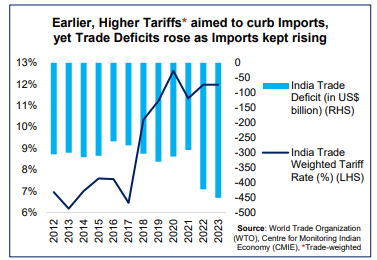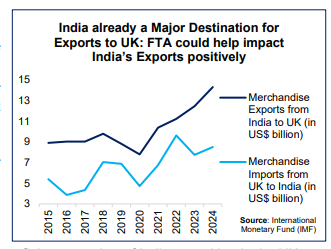Last Updated On: 30 Jul 2025
5 min read
What’s the Point?
- On July 22, 2025, Hon’ble Prime Minister of India, Shri Narendra Modi, and Hon’ble Prime Minister of the United Kingdom, Sir Keir Starmer, have announced the successful conclusion of a mutually beneficial India-UK Free Trade Agreement (FTA).
- This FTA opens up export opportunities for labour-intensive sectors, some of them being, textiles, marine products and leather, and other important sectors such as engineering goods, auto parts and engines, and organic chemicals. It additionally provides a significant boost to trade in services such as Information Technology / Information Technology Enabled Services, financial services, professional services, other business services and educational services.
- As per a Press Release by Press Information Bureau (PIB), the bilateral trade India and UK stands at nearly US$56 billion, which is projected to double by 2030. In that context, this agreement is a landmark event as it will deepen India’s economic relations with UK and bring trade liberalisation and tariff concessions.
What are FTAs?
FTAs are treaties between two or more countries designed to reduce or eliminate certain barriers to trade and investment, and to facilitate stronger trade and commercial ties between participating countries. Trade agreements occur at varying degrees of openness. While preferential trade agreements (PTAs) involve the lowest level of integration, which are limited to reductions in tariffs for a select list of goods, FTAs offer a deeper form of integration through tariff reductions in larger classes of goods.
Historically India has faced challenges with respect to FTAs, some of them being:
- Technical barriers limiting exports opportunities: Non-Tariff Barriers such as certification requirements have historically limited India’s exports potential
- Higher imports and limited exports gains: Despite establishment of prior FTAs, India’s trade deficit has increased. For instance: India’s trade deficit with ASEAN widened notably after the FTA came into effect in 2010
- FTAs covering goods rather than services on the exports side: This is a counterintuitive approach considering services has remained an area of competitive advantage for India
- Low utilization rate of the FTAs: As per a report published by Asian Development Bank and Deloitte, while FTA utilisation in developed countries has been higher than 65%, it is much lesser for Indian exporters and importers. To reap the benefits of an FTA, there is an increasing need for the exporters of participating nations utilize it by increasing the proportion of preferential goods exports from country A to country B.

India-UK FTA: Positive at the Micro Level....
This FTA helps to ensure comprehensive market access for goods, across all sectors, covering all of India’s export interests. India is expected to gain from tariff elimination on about 99% of the tariff lines covering almost 100% of the trade value offering significant opportunities for increase in the bilateral trade between India and the UK. In addition to potential positive impact on manufacturing across labour and technology intensive sectors, higher export opportunities and boost to trade in services stated earlier, some of the provisions in the FTA will help India’s bilateral relations with UK in the following manner:

- “Zero Duty” on 95%+ agriculture tariff lines by UK, providing India access to UK’s premium market for niche agri-products, which could lead to a 20% rise in exports of Agriculture and Allied Goods in the next 3 years
- Ease of mobility for professionals and opportunities for skilled Indian youth to open up in the UK, which is important due to UK’s strong financial and professional services sectors, and advanced digital infrastructure
- Exemption for Indian workers temporarily in the UK and their employers from paying social security contributions in the UK for a period of 3 years under the Double Contribution Convention, leading to noted financial gains for the Indian service providers and enhance their competitiveness in the UK market, which would create new job opportunities and benefit large number of Indians working in the UK
.....but a Major Positive at the Macro Level
While the eventual impact of this FTA on the Indian economy is yet to be seen, it could improve the sentiment at the global stage on India’s approach on trade deals, and could pave the way for impending bilateral trade agreements.
For instance, the 2nd round of negotiations for the India-New Zealand FTA was concluded successfully on July 25, 2025. This round saw an advancement in the shared objective of strengthening bilateral trade and economic partnerships in multiple areas like goods and services trade, investment, rules of origin, customs procedures and trade facilitation, reducing technical barriers to trade and economic cooperation. It is also being believed that the signing of the India-UK FTA could also actively lead to a shift in pace of the India-US trade deal timelines.
Key Takeaway: FTAs are important as they lay the foundation for stronger supply chains and economic resilience. For instance, amidst the rare earth magnet shortage caused by Chinese export restrictions, the Indian Government is in talks with the Australian Government for rare earth minerals through the India-Australia Economic Cooperation and Trade Agreement. Historically, while India has been cautious about signing FTAs to prevent subsidised goods from being dumped in India – a key reason for India not signing the Regional Comprehensive Economic Partnership – the Government is displaying a strong commitment to bilateral trade deals, with India-UK being the start of many more.
Sources: PIB, CMIE, WTO, IMF, Ministry of Commerce and Industry and other publicly available information
About Tuesday’s Talking Point (TTP): TTP is an effort by HDFC AMC to guide key conversations in the Indian financial markets and investing ecosystem. We aspire to do this by providing relevant facts, along with our perspective on the issue at hand. Please provide your feedback at this link: https://forms.office.com/r/Cr8JNjMGWk
Disclaimer: Views expressed herein are based on information available in publicly accessible media, involve known and unknown risks and uncertainties that could cause actual results, performance, or events to differ materially from those expressed or implied herein. The information herein is for general purposes only. Stocks/Sectors/Views referred are illustrative and should not be construed as an investment advice or a research report or a recommendation by HDFC Mutual Fund (“the Fund”) / HDFC Asset Management Company Limited (HDFC AMC) to buy or sell the stock or any other security. The Fund/ HDFC AMC is not indicating or guaranteeing returns on any investments. Past performance may or may not be sustained in the future and is not a guarantee of any future returns. The recipient(s), before taking any decision, should make their own investigation and seek appropriate professional advice.
MUTUAL FUND INVESTMENTS ARE SUBJECT TO MARKET RISKS, READ ALL SCHEME RELATED DOCUMENTS CAREFULLY.
Did you find this interesting?
Your opinion matters - share your thoughts and help us improve.

